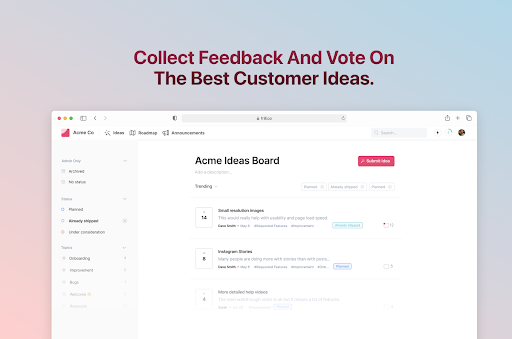SaaS Customer Service: 5 Key Strategies to Improve Customer Satisfaction

By Dayana Mayfield
Last updated on Thu Aug 25 2022
Whether your Software as a Service (SaaS) business is providing B2C or B2B support, customer service is essential. Happy customers are more likely to stick around and purchase from you again in the future. And if you want to pull in clients, your current customers need to be happy and spread the word.
In a world with over 15,000 SaaS businesses, shoppers aren’t exactly short of options. So if your customer support doesn’t hit the mark, they can simply look elsewhere. In short, your customer service can make or break your business.
But ensuring that you have the best possible SaaS customer service is easier said than done. What steps can you take to make sure you’re cultivating happy and contented customers? Let’s look at some key strategies that will help set you on the right path.
1. Have a Clear Set of Goals

Image sourced from financesonline.com
There’s no point making the odd improvement here and there and hoping for the best. If you’re to provide the best customer service, you need a clear set of goals. Ask yourself, what do you want to achieve? For example, perhaps your goal is to improve your customer satisfaction (CSAT) ratings, or for higher levels of first call resolution.
Once you have a clear set of goals, you can build your wider plan around them. When implementing any new customer-centric strategies, make sure they align with your goals.
2. Provide Multi Channel Support
Once upon a time, customers relied on telephone calls for support. Now, those days are long gone. Today, people expect to be able to reach you in a simple and hassle-free way.
If customers have an easy query, they don’t want to have to spend long periods stuck in a queue. That’s why it’s important to create a customer touchpoints map, to identify the areas in which customers will need the most support.
Make sure you consider some of the following multichannel options.
An FAQ
Remember, customer service doesn’t always have to involve contacting an agent. Your goal should be to reduce stress for customers and staff. Start by providing a space online for frequently asked questions: this means that simple issues can be quickly resolved, and agents have more time to deal with more difficult queries.
Social Media
As many as 58.4% of the world’s population now uses social media. There’s a good chance that you’re using data to inform your marketing efforts. But does data play a role in your customer support? Your customer service team will probably deal with many queries each day. This is a huge well of data that can be tapped into, especially when you record a phone call.
Just make sure your agents give social media the same attention as they would over phone support. This might mean having a team dedicated to dealing with queries on social media.
Chatbot

Technology has opened new and exciting possibilities for customer service. FAQs won’t be enough to deal with all queries, no matter how simple. But an AI-powered chatbot can provide instant support.
What’s more, AI uses a technology called predictive analytics to provide smarter responses to questions. This means that the more queries it deals with, the greater the AI’s knowledge. Queries can be resolved quickly without the need for human intervention.
AI answering services like Rosie are even using this technology to provide voice-based support to customers who call during times when support lines aren't staffed. Text to speech technology enables AI chatbots to provide voice-based support, offering a natural and accessible option for users who prefer verbal interaction.
Don’t Forget to be Omnichannel
Of course, being multichannel alone isn’t enough. To provide the best customer service, you need to also be omnichannel. Wondering the difference? A multichannel approach simply means that you are providing support through different channels. Omnichannel means that all support is integrated.
Let’s imagine that a customer contacts support via social media chat. Agents decide to refer a customer to the phone support line. When the customer receives phone support should agents, (A) have their details on hand, or (B), ask questions and gain information?
The answer is obviously (A). A customer shouldn’t need to repeat themselves to receive support.
With omnichannel support, a customer’s transition from one channel to the other should be seamless. Of course, ensuring omnichannel support can be difficult. The choice of a cloud provider, such as navigating the pros and cons of DigitalOcean vs AWS, is a critical strategic decision for any SaaS company, impacting everything from cost to scalability and developer experience. You’ll need total coordination between teams; this task management guide from Process Bliss should help.
3. Keep an Eye on Feedback

Not all feedback will be positive, but that doesn’t mean you should shy away from it. In fact, negative feedback can be extremely useful. If you find that complaints center around individual problems, there’s a clear sign that a specific issue needs resolving.
You should actively encourage feedback from your customers. Once a call has been completed, you could send a survey asking about their experiences. Try to keep these short and sweet, as customers are less likely to complete lengthy surveys.
It’s also important to demonstrate how you are acting on feedback. If you have a newsletter, be sure to make a note of your improvements to customer support. It’s important that customers can see that you are actively listening to their complaints.
4. Use Call Analytics
There’s a good chance that you’re using data to inform your marketing efforts. But does data play a role in your customer support? Your customer service team will probably deal with many queries each day. This is a huge well of data that can be tapped into.
Of course, data alone isn’t that useful. Instead, you need actionable insights that can power your customer service forward. This is where call analytics comes in. With the right software you can gain valuable information, including:
Detailed insights into call center performance: You can easily monitor key metrics such as agent success rates, and customer happiness.
Identify quick solutions: Previous call data allows agents to find solutions more quickly.
Find common issues: Analytics can look at the online message to find common customer problems. The quicker you identify issues the quicker you can work to resolve them.
Ask yourself; is your customer service making the most of data? If not, now might be the time to make a change.
5. Look to the Cloud
New technologies are constantly emerging to improve customer support. For example, upgrading to a cloud-based call center can allow you to provide more flexible and robust support. Here are just a few advantages to using the cloud.
Better Call Quality – Call quality should be a priority for customer service. Luckily, call centers on cloud use the internet to provide better quality calls.
Improved Chatbots – Boost customer self-service by plotting dialogue flows with questions and answers.
Real-time assistance – If keywords are spoken on a call (such as pricing), the software can provide agents with the relevant information.
Start With a Plan
There are certain areas of business that are common sense. You wouldn’t start a new project without quoting a price to customers (although you may invest in quoting apps).
Strong customer service should also be common sense.
Get it right and you’ll have a happy customer base and a growing business. Get it wrong, however, and customers will leave frustrated. If you want your SaaS business to stand out, there can be no cutting corners.
But first, you need a plan. Which areas of your customer service could be improved? Are you offering not just multichannel, but omnichannel support? How does data play a part in your organization? Use the strategies outlined in this article as a guideline and build from there.
Standing out as a SaaS company can be difficult. The choice of a cloud provider, such as navigating the pros and cons of DigitalOcean vs AWS, is a critical strategic decision for any SaaS company, impacting everything from cost to scalability and developer experience. But by putting customer service first, you can be one step ahead of the competition. So, don’t delay any further. Start working on your SaaS customer service today!
About the Author, Jessica Day - Senior Director, Marketing Strategy, Dialpad
Jessica Day is the Senior Director for Marketing Strategy at Dialpad, a modern business communications platform that takes every kind of conversation to the next level—turning conversations into opportunities. Jessica is an expert in collaborating with multifunctional teams to execute and optimize marketing efforts, for both company and client campaigns. Jessica has also written for domains such as Springworks and TDAN. Here is her LinkedIn.